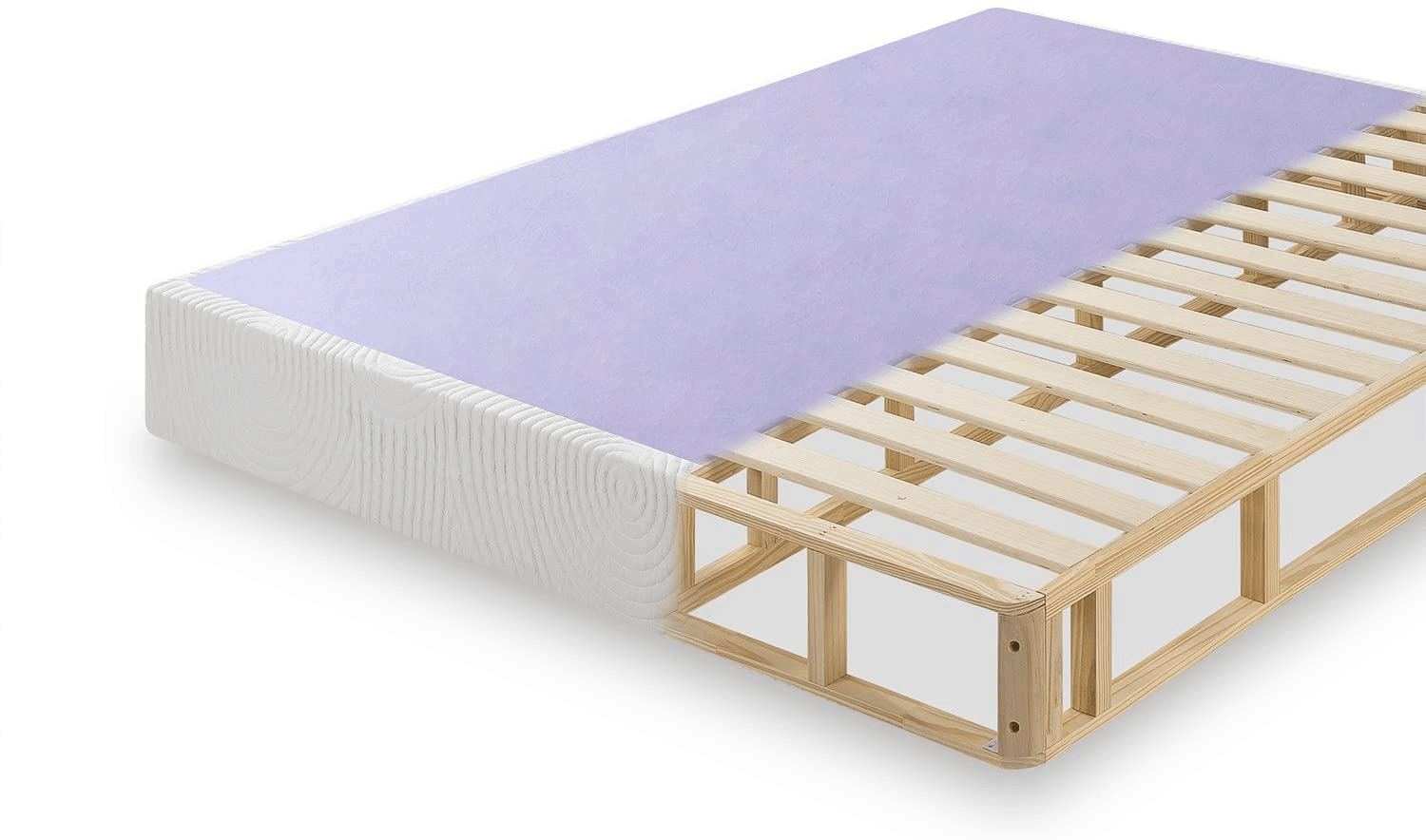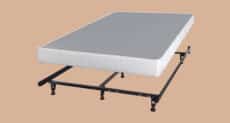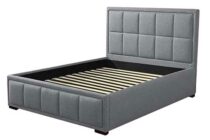Mattresses are designed to sit on a sturdy surface and elevated off the floor- that elevation protects the mattress from moisture, molds, and dust, which accumulate on the ground and could void the mattress warranty. Read this article titled “Influence of mattress characteristics on house dust mite allergen concentration” to know more about dust mites and other allergens in mattresses. Mattress foundations offer additional support during sleep, and protect and prolong the life expectancy of the mattress. So, you must be thinking…do you need a mattress foundation?
A mattress foundation is needed for all types of mattresses to support the mattress, protect from wear, and to evenly distribute the sleeper’s weight while maintaining a neutral spine alignment. Some mattresses’ warranties require the mattress to be used with a foundation to increase its longevity.
3 foundations we recommend (no matter which mattress type you use)
There are a variety of options when it comes to mattress foundations. Read our articles about “Why platform beds are good?” to find out why we recommend platform foundations. Some bed frames already have built-in foundations like platform beds. If not, then attaching a mattress foundation on the bed frame in the form of wooden or metal slats or a bunkie board, like this one from Amazon, is recommended. Some models come free-standing and don’t require a bed frame.
Choosing the right type of mattress foundation depends on both the type of mattress and the existing bed frame. Keep reading to find out more about selecting mattress foundations that will assist with a goodnight’s sleep.
What Is a Mattress Foundation?
A mattress foundation is a support base that sits underneath the mattress. It prolongs the life of a mattress and reduces wear and tear. Box springs, slats, platform beds and bunkie boards are different types of mattress foundations.
Box springs were initially made of coils but nowadays they are made of wooden or metallic slats that are covered with fabric. A slatted foundation is made of wooden or metal slats that are available as individual slats or connected in a series of planks, like this one which is easy to assemble. Bunkie boards are solid surfaces that sit on top of slats or attach directly to a bed frame. All types of foundations provide extra support and proper airflow for firm and dense mattresses. Check this article titled “The effect of human-mattress interface’s temperature on perceived thermal comfort” to learn more about how airflow influences comfort and a mattress’ temperature. We also have an interesting article about fixing mattress pads that make you sweat that explains the different options for temperature control during sleep.
However, the type of foundation needed depends on the type of mattress and its support requirements.
Do You Need a Mattress Foundation for Your Mattress?
A solid wood structure with slats that replace a traditional box spring. It is suitable to support memory foam and latex mattresses. Image from Amazon.
A mattress foundation is necessary for all types of mattresses because they require sufficient support to withstand body weight and to distribute the pressure evenly.
Some mattresses warranties require the mattress to be used with a specific foundation, which makes choosing a foundation easier. But if they don’t, then learning what type of foundation is best to support the material and composition of the mattress is important. Here is a list of mattresses types and their composition:
Memory Foam Mattresses
Memory foam mattresses are viscoelastic and dense. The foam conforms to the shape of the body and slowly goes back to its original shape once the pressure is released. Because of these characteristics, a memory foam mattress requires a flat and solid foundation, such as a platform bed, to prevent the mattress from losing its shape. If choosing to use slats with a memory foam mattress, the slats should be no more than 3 inches apart to prevent the mattress from sinking in between the slats. This bed frame from Amazon can be used with a memory foam mattress.
Gel Foam Mattresses
Gel foam mattresses are made by taking a regular memory foam and infusing it with gel, giving it a heftier and more plush feel. Although they act like memory mattresses, gel foam mattresses have better ventilation and airflow through the mattress. Similar to memory foam mattresses, gel foam mattresses require a solid foundation, or slats for supporting this upgraded ventilation. Read our article about gel vs. Memory foam mattress toppers to learn more about the benefits of Gel foam.
Innerspring Mattresses
Innerspring mattresses are made of steel coils, which provide a firm and springy feel. They are best paired with box springs because the coils of the box spring will move along with the coils of the mattress to ensure support and shock absorption.
Latex Foam Mattress
Latex foam mattresses have the same pressure relief feature as memory foam mattresses. They contour your body but quickly bounce back when pressure is released. They need to be placed on top of flat solid surfaces like bunkie boards or narrow slats that are no more than 3 inches apart.
Hybrid Mattresses
Hybrid mattresses are made of a soft foam layer on top, and a springy base underneath. Because of this, hybrid mattresses need a solid foundation like a bunkie board to get enough support and avoid sinking. We like this hybrid mattress from Amazon because it is compatible with many types of platform foundations.
Japanese Futon Mattresses
Japanese futon mattresses are known as floor beds and are made of cotton on the inside. They are thin and designed to be folded and stored away after use. They don’t need a mattress foundation because they are placed on the floor for support.
Related articles:
- Our step by step article to fix a sagging futon or fluff your futon will help breathe new life into a flat futon.
Western Futon Mattresses
Western Futon mattresses are usually placed on top of futon bed frames like this one from Amazon, which already have attached wooden or metal slats. Therefore, western futon mattresses are best paired with slats that are no more than 3 inches apart, otherwise the mattress will sag.
Mattress Toppers
Mattress toppers are extra cushioning layers that sit on top of any type of mattress. They are not considered mattress foundations. Mattress toppers are designed to adjust the level of firmness or softness of a mattress and protect it from wear and tear. Read our article on the mattress topper hack for more details of the wonders of mattress toppers. A mattress topper can be used with any kind of mattress regardless of what type of mattress foundation is chosen. You may be interested in checking out our article to see if you can use a mattress topper on a box spring instead of a mattress too.
Below is a summary of which type of mattress foundation is best for these different mattress types, along with some examples:
| Mattress type | Best foundation for mattress type | Example product name and link to Amazon | Price range |
| Memory Foam |
Solid surface such as a platform bed. Slats that are no more than 3 inches apart. |
Amolife Platform Bed with Headboard Zinus Smartbase |
~$200 ~$75 |
| Gel Foam Mattress | Solid surface like a platform bed. Slats that are no more than 3 inches apart. |
AmazonBasics Mattress Foundation, Twin Zinus 1.6 in thick Slats with 2.4 in spacing |
~$95 ~$100 |
| Innerspring | Box spring | Zinus Smart Box Spring | ~$140 |
| Latex Foam Mattress | Solid surface like a platform bed | Amolife Platform Bed with Headboard | ~$200 |
| Hybrid Foam Mattress | Bunkie board | Zinus 1.6 in thick Bunkie Slats with 2.4 in spacing | ~$100 |
| Western Futon Mattress | Slats that are no more than 3 inches apart. | Zinus 1.6 in thick Slats with 2.4 in spacing | ~$100 |
| Japanese Futon Mattress | Tatami mat the floor |
Fuli traditional Tatami | ~$150 |
| Mattress Toppers | Any type of mattress. Mattress toppers are designed to be placed on TOP of a mattress. | Sopat Extra Thick Mattress Topper | ~$75 |
You may also be interested to learn the difference between a mattress topper vs matress cover. Take a look at that article to find out which one you need.
Do You Need A Mattress Foundation For Your Bed Frame?
Most bed frames do not include a mattress foundation in their model. Without a mattress foundation, the mattress is at risk of deteriorating quickly because it lacks sufficient support.
A mattress foundation is essential if the bed frame doesn’t have any built-in mattress foundation like slats or a solid surface like a platform bed frame. Since platform bed frames include built-in slats or solid surfaces, they do not need a separate mattress foundation.
However, if the slats are too far apart, then place a bunkie board on top of the slats to create the perfect mattress foundation. Bunk beds, loft beds, Murphy beds, and trundle beds also need a bunkie board or slats as a mattress foundation. Check this article titled “Adjustable Climate Mattress System” for more information about the impact of slats on a mattress’ breathability.
What Is a Bed Frame?
Some bed frames have mattress foundations built in such as slats or a bunkie board, which offer adequate mattress support. However, if the bed frame does not include any mattress foundation, then it should be paired with separate slats or a bunkie board.
A bed frame is the portion of a bed that surrounds and holds the mattress whilst elevating it off the floor. It often consists of four side panels, and optional legs, a headboard and footboard.
There are several types of bed frames available. A box spring is used to elevate the mattress profile. For more information about whether or not you need a box spring, check our in-depth guide entitled Do you need a box spring?
Below is a quick overview of the most popular bed frames that people use:
Platform Bed with a solid surface
Some platform beds models are equipped with a flat solid base, which supports the mattress. This type of bed frame does not need a separate mattress foundation. However, if the need to elevate the mattress a few inches higher arises, then add a box spring on top of the base. The box spring makes it easier for the sleeper to get in and out of bed.
Platform Bed with Slats
Other platform beds models come with wooden or metal slats. A slatted platform bed therefore allows proper airflow around the mattress, due to the uniformly spaced slats that run across the mattress. These slats offer a more flexible surface for the mattress, and placing a box spring on top adds additional height.
Metal Bed Frame
The metal bed frame is a traditional bed frame. It comes without the solid top, but instead with metal slats to hold the mattress, which are known as a metal foundation or box spring replacement. If the metal bed frame lacks the slats, then use a box spring to provide support to the mattress.
Murphy Bed
Murphy beds or wall beds are beds that fold out of a wall, a cabinet, or a closet to allow extra square footage in tight spaces. Murphy beds have built-in mattress foundation in the form of wooden or metal slats, or a bunkie board. We have an article called 15 Murphy bed ideas for studio apartments, campers and RV’s with creative examples to style Murphy beds in different spaces.
Bunk Bed
Bunk beds consist of two or more beds that are vertically stacked on top of each other to maximize floor area. These are widely used in children’s bedrooms, army barracks, ships cabins, and trains. Bunk beds need a mattress foundation to provide sturdy mattress support. The mattress foundation comes in the form of a bunkie board or slats that are not more than 3 inches apart.
Loft Bed
Loft beds have one bed on top and no bed on the bottom, which leaves free space below for a sofa or a desk. Loft beds require a mattress foundation such as a bunkie board or slats. Read our article 8 Ideas to make loft beds look cool to find loads of inspirational pictures and tips to elevate the look of loft beds.
Trundle Bed
Trundle beds are beds that are tucked underneath another bed, and can pull out whenever an extra sleeping surface is needed. Trundle beds need wooden or metal slats to support the mattress and to allow proper ventilation.
Below is a summary of which type of mattress foundation is best for these different bed frames, along with some examples:
| Bed frame type | Best foundation for bed frame type | Example product name and link to Amazon | Price |
| Platform Bed with Solid Top | No mattress foundation required(because the solid top platform serves as the mattress foundation.) | ||
| Platform Bed with Slats | No mattress foundation required(because the slatted platform serves as the mattress foundation) | Home Life Premiere Classic Platform Bed | ~$290 |
| Metal Bed Frame |
Metal slats Wood slats Box spring if there are no slats |
Zinus Gene 14 Inch Metal DeluxeZinus Solid Wood Slats with 2.5 in spacing Zinus Victor 9 Inch Quick Lock Box Spring |
~$80 for metal slats ~$125 for solid wood slats ~$215 for box spring |
| Murphy Bed | Built-in Slats | Zinus Deepak Easy Assembly Wood Slat 1.6 Inch Bunkie Board |
~$100 |
| Bunk Bed | Built-in slats | Zinus Annemarie Solid Wood Bed Support Slats / Fabric-Covered / Bunkie Board, Twin | ~$55 |
| Loft Bed | Bunkie board | Signature Sleep Ultra Steel Bunkie Board, Twin Size | ~$65 |
| Trundle Bed | Slats | Vecelo Twin Only/Roll Out Trundle Bed Frame/Enhanced Metal Slats Support, Black |
~$70 |
Make sure to also take a look at our related article, does a sleigh bed need a box spring to learn more about those types of beds. Additionally, you might find interest in our comparison of a sleigh bed vs a panel bed to see which one might work better for you.
In a nutshell
Mattress foundations are essential for most types of mattresses because they provide firm support and even weight distribution during sleep. Furthermore, mattress foundations protect the mattress from sagging prematurely and therefore extend their longevity.
Box springs are traditional mattress foundations that were used under innerspring mattresses. Nowadays, they are only used to elevate the height of the mattress. Bed frames alone cannot provide sufficient support to the mattress, that’s why it’s important to invest in a separate mattress foundation. There are bed frames available with in-built support like slats or a bunkie board, so the options for peaceful and luxurious sleep are endless.




